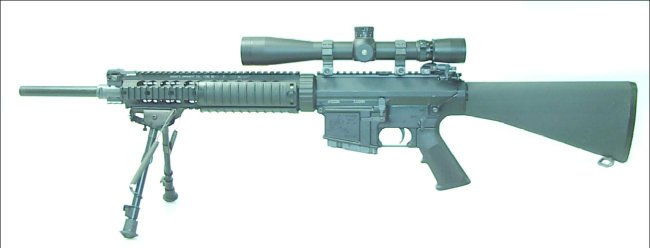
Knights SR-25 rifle, civilian version with 20" barrel.

Knights SR-25 carbine, civilian version with 16" barrel and telescopic buttstock.

US Navy / USMC Mark 11 Model 0 (Mk.11 Mod.0) sniper rifle system, with 10-round magazine, daylight telescope sight and bipod.

US Navy / USMC Mark 11 Model 0 (Mk.11 Mod.0) sniper rifle system, with 20-round magazine, daylight telescope sight and installed quick-detachable sound suppressor.

US Army XM110 Semi-Automatic Sniper Rifle (XM110 SASR), with daylight telescope sight, bipod and quick-detachable sound suppressor.
| SR 25 rifle | SR 25 carbine | MK 11 Mod 0 | XM 110 | |
| Caliber | 7,62×51 NATO / .308 Winchester | |||
| System | Semi-automatic, gas operated | |||
| Overall length | 1118 mm | 940 / 860 mm | 1158 mm | 1187 – 1200 mm |
| Barrel length | 508 mm (20") | 406 mm (16") | 508 mm (20") | 508 mm (20") |
| Weigth | 4,31 kg (less scope and magazine) | 3,86 kg (less scope and magazine) | 6,9 kg (with scope and bipod, less magazine) | 7,26 kg (with scope and bipod, less magazine) |
| Magazine | 10 or 20 rounds, detachable | |||
The SR 25 rifle (Stoner Rifle, model 25) was developed by Reed Knight (owner of Knights Armament Co) and Eugene Stoner (designer of M16 and Stoner 63 rifles among other things) during early 1990s. In essence, the SR 25 was the AR-15 rifle scaled up to shoot 7,62×51 / .308 Win ammunition, with up to 60% of parts of new rifle being interchangeable with standard AR-15 components. This rifle sold well among civilian shooters who needed an accurate semi-automatic rifle in 7,62 / .308 caliber for hunting or target shooting. This rifle also found a favor among US Military – during early 1990s it was adopted by US Navy SEAL groups, as Mark 11 Model 0 sniper rifle system; use of Mk.11 Mod.0 rifle was later extended to US Marine Corps. Mark 11 Model 0 rifle system included the semi-automatic SR-25 rifle, a quick-detachable sound suppressor, also developed by Knights Armament Co, Leupold Vari-X Mil-dot telescope sight, Harris bipod, 20-round magazines and other necessary accessories. In 2005, a modified version of the SR-25 / Mk.11 rifle won US Army Semi-Automatic Sniper Rifle (XM110 SASR) competition, and today it is being issued to US Army snipers, in attempt to replace venerable M24 Sniper Weapon System. A certain controversy exists about this replacement, as some experts doubt that Knight's semi-automatic XM110 rifle could equal long-range accuracy of the bolt-action M24. However, Knights Armament Co claims that SR-25 is capable of 0.5 MOA accuracy with match ammo, and in the field Mk.11 or XM110 rifle can proved accurate and rapid fire out to 600 meters or even more, depending on particular circumstances and proficiency of operator. Use of quick-detachable silencer / sound moderator also has several benefits, the most obvious being concealment of the operator's position, as silencer decreases the sound of gunshot and completely eliminates muzzle flash. Another, less obvious benefit is that silencer also acts as an effective muzzle brake, decreasing recoil and thus permitting faster follow-up shots.
All rifles built on SR-25 platform share same basic action, which is based on AR-15 / M16 system. This is a gas-operated system with direct-impingement gas drive, which has no gas piston. Instead, powder gases are fed from the barrel and through a stainless-steel tube back into the receiver, and then into the cavity inside bolt carrier through the gas key. Inside the bolt carrier, powder gases push it back against the bolt, thus first causing the bolt to rotate and unlock from the barrel, and then to cycle the action. The rotary bolt has 7 radial lugs and improved extractor. Both upper and lower receiver halves are made from aircraft grade aluminum alloy, and connected by cross-pins. There is no "forward assist" button on the SR-25 rifles; the brass defelector is present. Barrels are of match class quality, and enclosed into free-floated forearm, fitted with Knights-made and designed Picatiny rails system. Because of AR-15-style recoil buffer, which extends rearwards fro the receiver, SR-15 cannot be fitted with folding buttstock; most rifles are fitted with fixed butt, while SR-25 carbines are fitted with telescoping buttstock. Trigger is also of match grade, fully adjustable.
Military versions of the SR-25, known as Mk.11 Mod.0 (USN / USMC) and XM110 (US Army) have some differences from civilian rifles. First of all, these rifles are fitted with proprietary sound moderator / silencer quick mount, located on the barrel just in front of the gas block. These rifles also finished to military specifications, and equipped with back-up iron sights (marked up to 600 meters and installed on folding bases). XM110 rifle also features a different buttstock, which is adjustable for length of pull, as well as different style forend rail system and a flash hider on the barrel. Military rifles are usually issued along with Harris bipod, Leupold variable-power 3,5-10X sniper scope, and a number of other accessories, including soft and hard carrying cases.